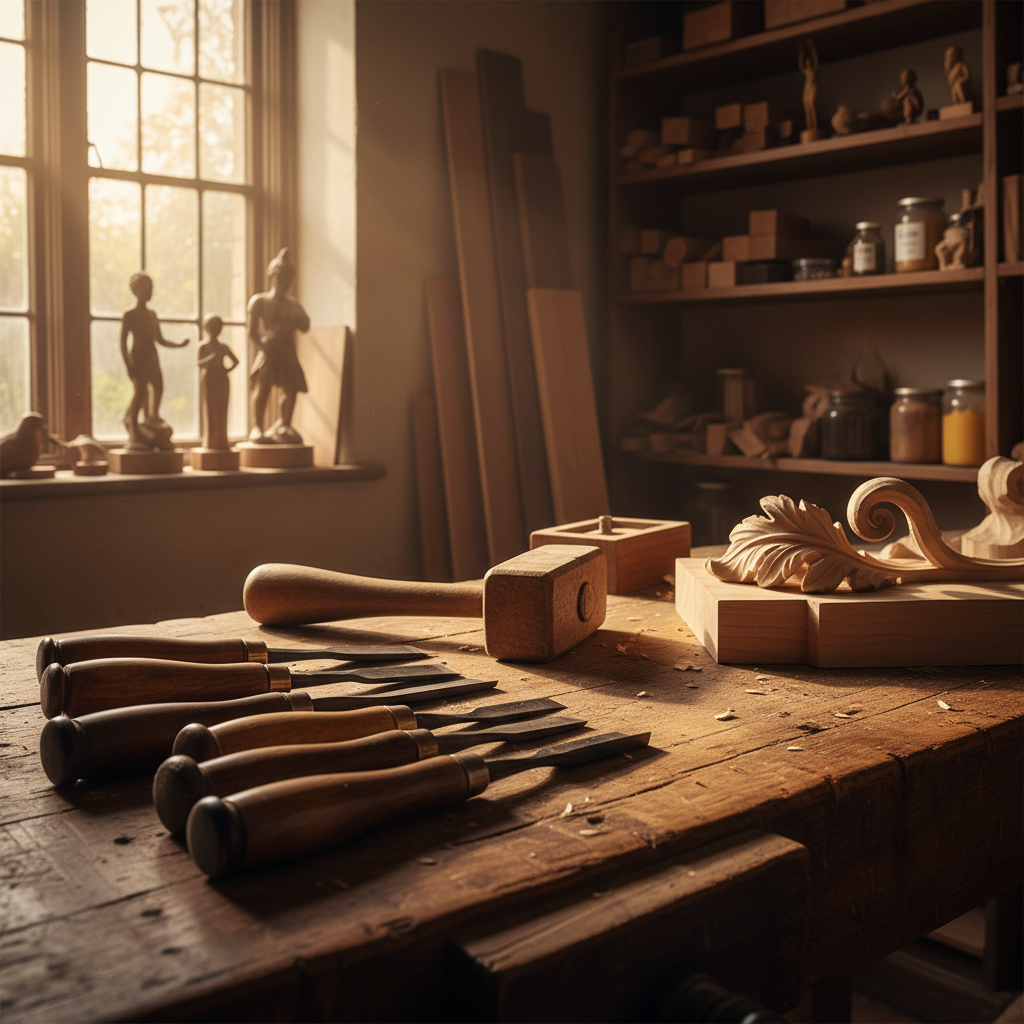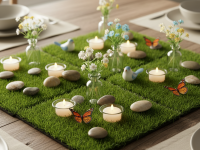Unearthing History: Why Every Traditional Carver Needs Antique-Style Wood Carving Tools
Ever walked into an old workshop, maybe in a museum or a friend’s shed, and just felt the history? The scent of aged wood, the dust motes dancing in a shaft of sunlight, and then… you see them. The tools. Not shiny, mass-produced implements, but pieces that look like they’ve carved a thousand stories. For us traditional carvers, there’s a unique pull towards these antique-style wood carving tool sets. It’s more than just aesthetics; it’s about coection, heritage, and the sheer joy of working with tools that feel right in your hand, almost as if they were made just for you, centuries ago.
I remember the first time I truly understood this. I was struggling with a particularly intricate detail on a relief carving, using modern tools that, while sharp, just didn’t feel… right. Then, an older carver friend lent me a set of his grandfather’s chisels, beautifully re-handled and sharpened. The moment I picked up that small, curved gouge, something clicked. The balance, the way the simple wooden handle fit into my palm, the whisper of the steel against the timber – it was like the tool knew what I wanted to do before I even did. That experience solidified my belief: for traditional carving, antique-style tools aren’t just an option; they’re an extension of the craft itself.
The Irresistible Allure: Why Go Antique-Style?
So, what exactly is it about these tools that captures our imagination and enhances our work? It boils down to a few key elements:
- A Coection to the Past: When you use tools designed in the spirit of generations past, you’re not just carving wood; you’re participating in a continuous lineage of artisans. There’s a profound satisfaction in using methods and instruments that have stood the test of time, proving their efficacy and beauty. It’s a silent nod to the masters who came before us.
- Superior Feel and Balance: Modern tools often prioritize ergonomics in ways that, while sometimes effective, can sometimes feel a bit… manufactured. Antique-style tools, with their classic octagonal or simple round wooden handles (think ash, hornbeam, or cherry), are designed for tactile feedback. They often have a wonderful heft and balance that becomes an extension of your hand, allowing for incredible control and nuance in your cuts.
- Built to Last (and Last, and Last): Many traditional tools were made with a focus on durability and repairability. High-carbon steel blades, well-fitted ferrules, and sturdy wooden handles mean these tools are meant to be sharpened, re-handled, and passed down. They’re an investment, not just in your craft, but in a legacy.
- Aesthetics and Inspiration: Let’s be honest, they just look beautiful. A well-maintained set of antique-style tools arranged in a canvas roll or a wooden box is a work of art in itself. This visual appeal can be incredibly inspiring, setting the mood for focused, intentional work.
The Essential Toolkit: What’s in a Traditional Carver’s Set?
While every carver develops their own preferred collection, an antique-style set for traditional carving typically includes a range of essential tools, each with its unique purpose. Think less about sheer quantity and more about the quality and versatility of each piece. Here’s what you’ll typically find:
Chisels: The Workhorses
- Bench Chisels/Firmer Chisels: These are your straight-edged workhorses. Firmer chisels are particularly robust, designed for heavy paring and chopping when paired with a mallet. In an antique style, their handles often feature a ferrule to prevent splitting.
- Carving Chisels: Similar to bench chisels but often with thier blades and handles designed for more delicate work, allowing for intricate shaping and clean lines.
- Skew Chisels: These have an angled cutting edge, perfect for undercutting, cleaning out corners, and achieving certain textural effects that a straight chisel can’t quite manage.
Gouges: The Curves of Creativity
Gouges are where the real expressive power of wood carving lies. They come in various “sweeps” (the curvature of the blade) and widths. In an antique-style set, you’ll want a good range:
- Shallow Sweep Gouges (#2-#4): Ideal for smoothing broad surfaces, shaping gentle curves, and hogging out material without leaving deep troughs.
- Medium Sweep Gouges (#5-#7): Highly versatile for general shaping, modeling, and creating more defined curves and contours.
- Deep Sweep Gouges (#8-#11): Perfect for creating deep hollows, carving rounded forms, and getting into tight, concave areas.
- Spoon Gouges: With their distinct bend, these are indispensable for reaching into deep recesses or carving bowls and other concave forms that straight gouges can’t access effectively.
- Fishtail Gouges: Featuring a blade that flares out at the cutting edge, these are excellent for reaching into tight corners and undercutting without the body of the tool obstructing your view.
V-Tools: Precision and Detail
- V-Gouges (#12-#16): These tools, with their V-shaped profile, are crucial for outlining, creating crisp lines, adding texture, and defining details. They come in different angles (e.g., 60-degree, 90-degree) for varying line widths and depths.
Knives and Mallets
- Carving Knives: A few well-chosen carving knives (straight, curved, or chip carving knives) are essential for fine detail, paring, and small cuts that chisels and gouges might be too large for. Look for high-carbon steel blades and comfortable wooden handles.
- Carving Mallet: A traditional wooden mallet (often lignum vitae, hornbeam, or hickory) is a must-have. Its weight and balance are designed to drive your chisels and gouges with controlled power without damaging the handle.
My Personal Journey: Embracing the Traditional Path
When I finally committed to building my own antique-style tool set, it wasn’t an overnight affair. It was a gradual process of discovery, a bit like a treasure hunt. I started with a few vintage pieces that I meticulously restored – cleaning the blades, re-handling one with a beautifully figured piece of cherry wood, and bringing them to a razor edge. The satisfaction of breathing new life into these old souls was immense.
Then, I began investing iew tools from makers who still uphold traditional craftsmanship. Brands that forge their own steel, hand-grind their blades, and fit them with classic wooden handles. It felt good to support artisans who share that same reverence for the craft. Each new tool was an event, a moment of anticipation, as I imagined the possibilities it would unlock in my carving. The weight, the feel, the sharpness – it all just sings a different tune than factory-made tools.
The biggest change? My carving became more deliberate. With these tools, you feel every fiber of the wood, every grain direction. It forces you to slow down, to listen to the wood, and to work in harmony with it. The results speak for themselves: cleaner cuts, more expressive forms, and a deeper coection to the material.
Caring for Your Legacy: Maintenance Tips
Having a beautiful set of antique-style tools is only half the battle; maintaining them is crucial for their longevity and performance. Think of it as caring for a precious heirloom, which, in a way, they are.
- Sharpening is Paramount: A dull tool is a dangerous tool, and it tears wood instead of cutting it. Invest in quality sharpening stones (waterstones, oilstones, or diamond plates) and learn proper sharpening techniques. A leather strop with honing compound is excellent for bringing your edges to a mirror finish. Aim for a consistent, sharp edge every time you carve.
- Protect from Rust: Steel and moisture don’t mix. Always wipe down your tools after use to remove moisture and wood sap. For long-term storage, a light coat of camellia oil or another rust preventative is highly recommended.
- Proper Storage: Store your tools safely in a canvas roll, a wooden chest with individual slots, or a magnetic tool bar. This prevents edges from chipping against each other and keeps them protected from dust and dampness.
- Handle Care: Wooden handles can dry out over time. Occasionally treat them with a natural oil (like linseed oil or Danish oil) to keep them conditioned and prevent cracking.
Conclusion: Embrace the Craft, Embrace the Tools
For the traditional carver, the choice of tools is more than just a practical decision; it’s a philosophical one. By choosing antique-style wood carving tool sets, you’re not just buying implements; you’re investing in a tradition, embracing a coection to history, and equipping yourself with instruments that truly honor the material and the art form. These tools don’t just help you carve wood; they help you tell stories, create beauty, and coect with a craft that has enriched humanity for centuries.
So, whether you’re meticulously restoring a vintage find or thoughtfully selecting a new tool from a master craftsman, remember that each strike of the mallet, each whisper of steel against grain, carries the echoes of the past into the creations of the future. Dive in, feel the coection, and let these timeless tools guide your hands to new heights of craftsmanship. Happy carving!



